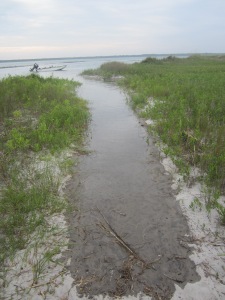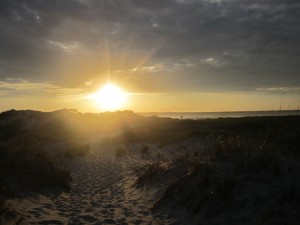Super Moon, Super High Tide
The day before my daughter’s birthday we took our boat out to swim along the barrier island beaches off the coast of our neighborhood. Little did we know that May 4th was the day the moon’s closest to Earth, known as a Super Moon. While many recognized this Super Moon by how bright the Moon was, it was most obvious to me from the significantly strong high tide.
As we approached the two islands that we usually visit, in between Figure Eight Island and Lea Island, the barrier islands were no where to be seen. It was still three hours from high tide, yet the islands were already well covered with ocean water. Presuming it was the peak of high tide– which even on a normal high tide doesn’t entirely cover the island– we made our way to Lea Island. I was astonished to discover the inlet we usually anchor in filled with water, so much that the pathway to the beach had turned into a tidal creek.
(The tide had already pushed this far up the walking path three hours before its peak!)
Lea Island
Aside from the incredbile high tide, one of the first things I noticed as we approached Lea Island were the large number of Red Winged Blackbirds. I’ve seen them throughout the year along Futch Creek, but never realiized thattheir nesting grounds were on Lea Island. 
As we walked up the path (now tidal creek) I noticed at least six of them flying throughout the Marsh grasses along the intracoastal side of the island. They continuously called to each other, and I was able to film this one Red Winged Black bird above calling. (It’s not the most exciting footage, as it only calls once, and I appologize for the wobbly footage, as I was holding a wiggly baby!)
Aside from the birds, Lea Island was an unoccupied beach! (Another boater and his son did arrive while we were there, and kindly gave my daughter a sand dollar they’d found without knowing it was her birthday!)
There are three military Blackhawk Helicopters flying overhead Lea Island in the picture above– you probably notice them flying over our neghborhood frequently too; they’re incredibly loud!
We left Lea Island as the sun was setting, and you can see the marsh reeds barely peeping out of the water as the tide continued to rise.
Within two weeks from the Super Moon, there was also a New Moon. With the New Moon comes another strong tide– occuring nearly every two weeks– known as a Spring Tide. Below is a picture on Futch Creek during the Spring tide.
Other bird watching along the creek–
Painted Buntings
Lately I’ve noticed both male and female Painted Buntings frequently–which is surprsing because of their shy behavior–and was excited to see this male female pair on our feeder together. The male Painted Buntings, with a blue head, green back,and red belly, are the most colorful songbird in North America (on right in photo below). Their lesser known female counterparts, shown on the left below, are just as beautiful in my opinion, with different shades of green and light yellow. Female buntings are one of the only true green birds native to North America. They typically hide in foilage or trees, but are also known to forrage on the ground.
Egret
Below, a Great White Egret lands in the marsh.
Osprey
Towards the end of last week, every day around supper I noticed a small group of Osprey (usually 3) flying and calling over the Creek and Pines in our backyard. I could be wrong, but it almost seemed like the parents (or one parent and two young) were training the juvenile Osprey how to fly, call, and likely, fish. They would fly in small circles synchronizedand calling, and then perch in separate trees about 25 feet apart. They would then call to each other while perched in separate Pines. The one, seemingly smaller Osprey also sounded like its call was more immature, but who knows?!














